My homemade shoyu ramen is packed with the slurp-worthy umami of my favorite ramen shop. But I can make it at home for a fraction of the cost. And the soy sauce based broth is crazy satisfying whether I use springy fresh ramen noodles or just scavenge a brick of dry ramen from my snack pantry. Ready in just 25 minutes from start to finish!
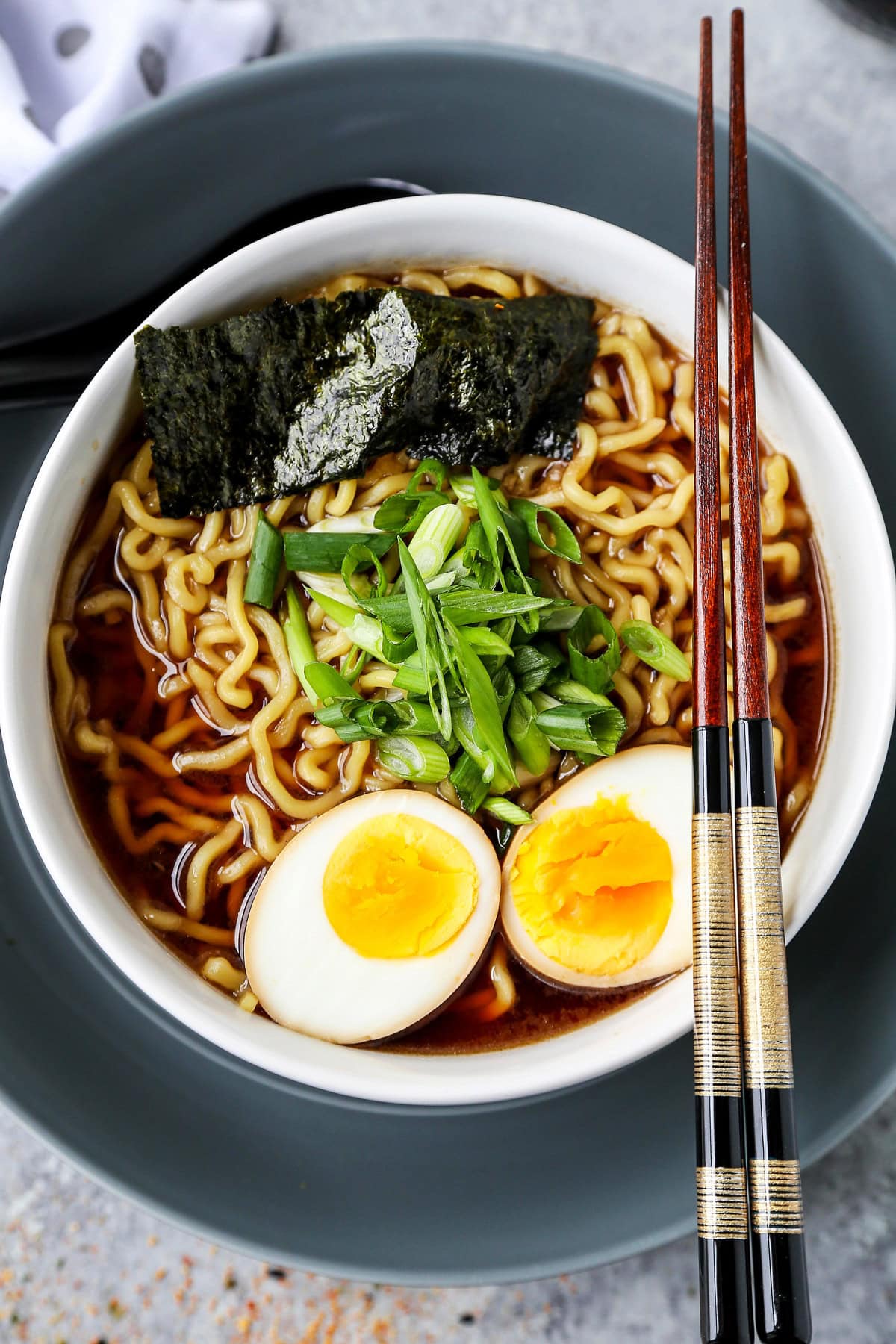
When I’m making ramen at home, I try to keep it quick and easy. I leave the complex stuff like tonkotsu broth (that takes literal days to make) to the ramen kings at Ippudo. So when I created this simple shoyu ramen recipe, I was expecting good – but I got great instead.
Ben and I were both frankly a little surprised by the nuanced flavor of the ramen broth. I developed it with a simple combination of soy sauce, sake, mirin and dashi. It’s packed with earthy umami, dry sweetness and saline notes. Once I added a little garlic and ginger for aromatics, I knew I had a broth that I had to share. FYI, I slurped two huge servings of shoyu ramen that day, then sat down at the computer to write this post.
Table of Contents
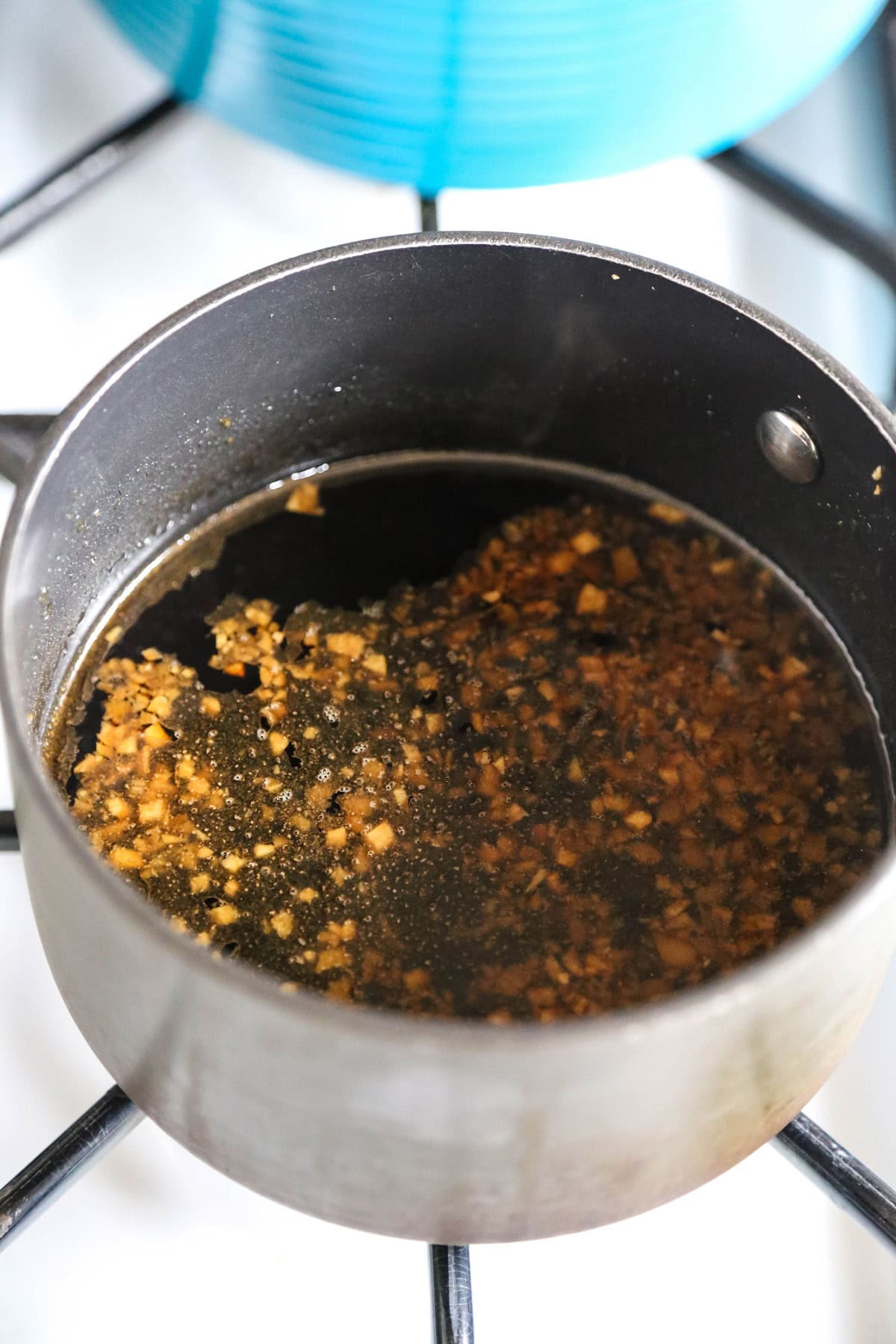
Ingredients
Scroll to the bottom of this page for the full recipe steps and measurements.
- Fresh Ramen Noodles: I use fresh or fresh/frozen ramen noodles when possible. They’re springy and perfectly chewy. But I try not to get too hung up on the ‘fresh’ aspect too much. Sometimes the perfect noodles are whatever I’ve got handy. Packaged dried ramen noodles can be delicious. And, in a pinch, a par-fried, dehydrated block of noodles I salvaged from a 25¢ packet of Top Ramen will do just fine. There’s absolutely no shame in keeping things cheap and cheerful when it comes to making homemade ramen.
Wavy, curvy noodles tend to be used in miso ramen. Straight and thin noodles usually come in the more rustic, thick tonkotsu soup in the south of Japan.
Soup Base
- Sesame oil: Sesame oil is delightfully toasty and nutty.
- Garlic and Ginger: My favorite aromatics.
- Soy Sauce: I use Japanese soy sauce (shoyu) for big time umami.
- Cooking Sake: While I use cooking sake most times, I’ve also use drinking sake when making Japanese ramen at home. Cooking sake contains added salt.
- Dashi: Dashi is a delicate briny sea stock made with kombu and katsuobushi (bonito flakes. I like to make my own homemade dashi. But I sometimes rehydrate instant powdered dashi.
- Mirin: Mirin is a Japanese rice wine I rely on for mild sweetness.
- Ramen Water: This is just reserved pasta water I extract from the pot just before draining my cooked noodles.
Topping Suggestions
- Ramen egg: Aside from chashu pork, ramen eggs are one of the most well known ramen toppings. While optional, I almost always use these custardy, jammy seasoned eggs.
- Menma: Pickled bamboo.
- Dry Nori Sheets: Nori is an edible seaweed, dried and pressed into thin sheets.
- Chopped Green Onion: AKA: chopped scallions.
- Ground White Pepper: Woody, floral and sharp.
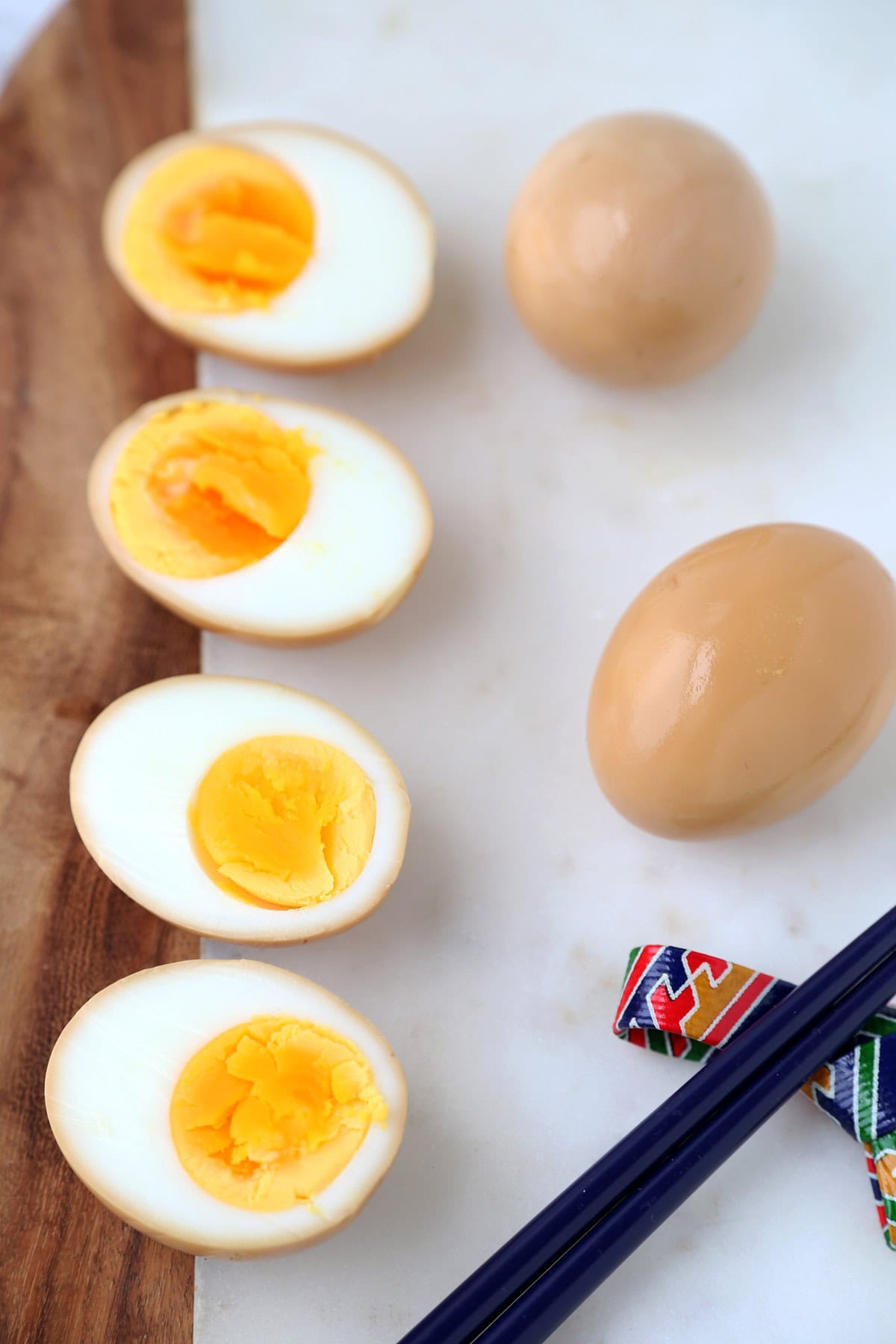
How To Make It
- Make the soup base. In a soup pot over medium high heat, sauté garlic and ginger in sesame oil until fragrant. Then add the soy sauce, sake, dashi and mirin. Once boiling, lower the heat, cover and simmer for about 15 minutes.
- Cook the ramen noodles and reserve pasta water. In a separate pot, boil your noodles according to the instructions on the package. Just before draining, be sure to reserve 1 cup of the noodle water. Add the hot water to the shoyu soup base and stir.
- Drain the noodles. Divide the cooked noodles evenly between two bowls.
- Assemble and serve. Pour soup into bowls and add desired toppings. Serve immediately.
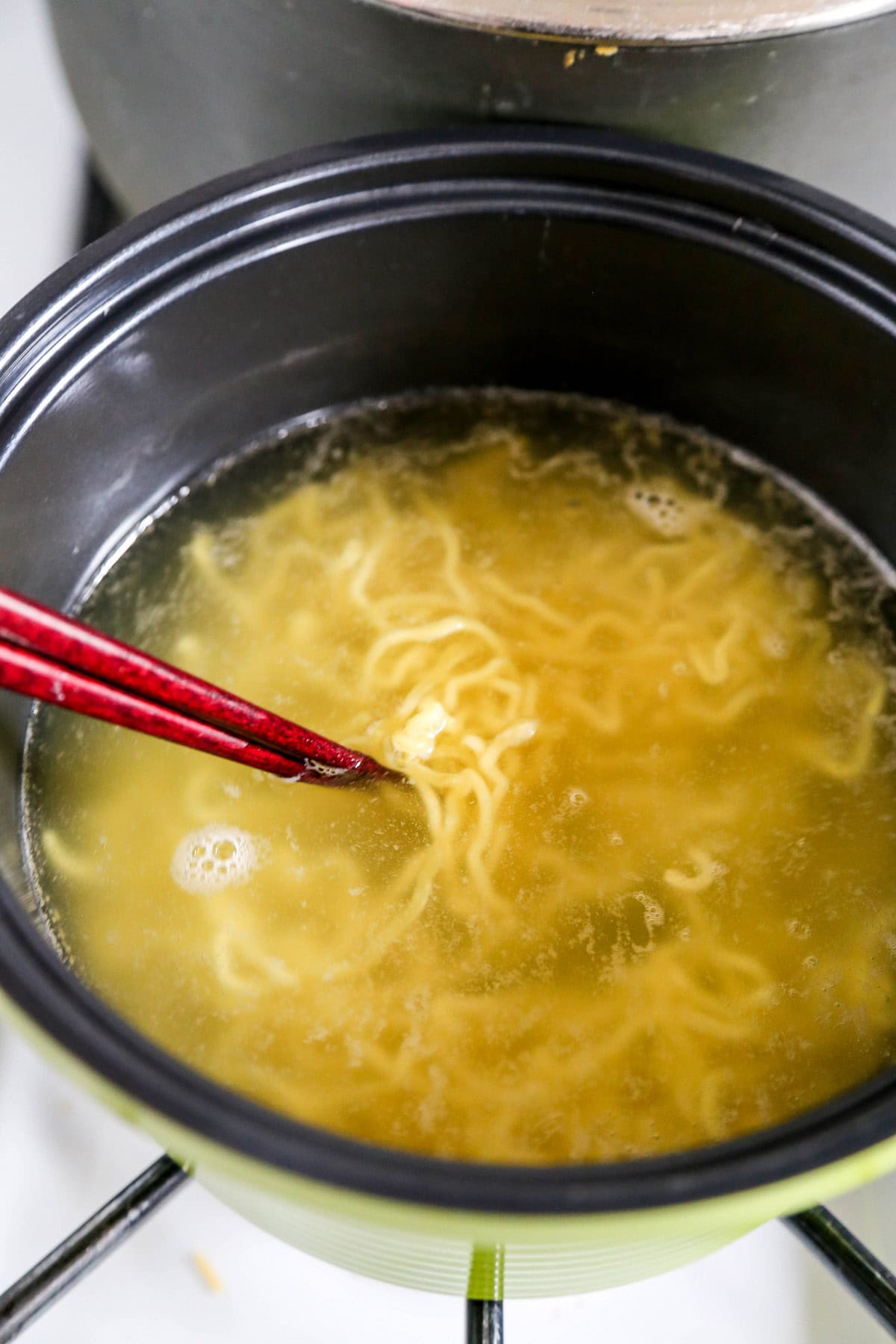
Expert Tips
- Perfectly done noodles. I like my ramen noodles on the al dente side. So I pull them off the heat a minute before I think they’ll be perfectly cooked. Much like spaghetti, they’ll continue to cook a bit after being taken out of the boiling water. Plus, since I’m putting them into hot soup before serving, they’ll continue to soften even more.
- The reason for reserving pasta cooking water / ramen water. The noodle cooking water is piping hot and flush with the flavor essence of the alkaline ramen noodles I just cooked in it. I use that cooking water to cut the concentrated soup base down to a perfect strength.
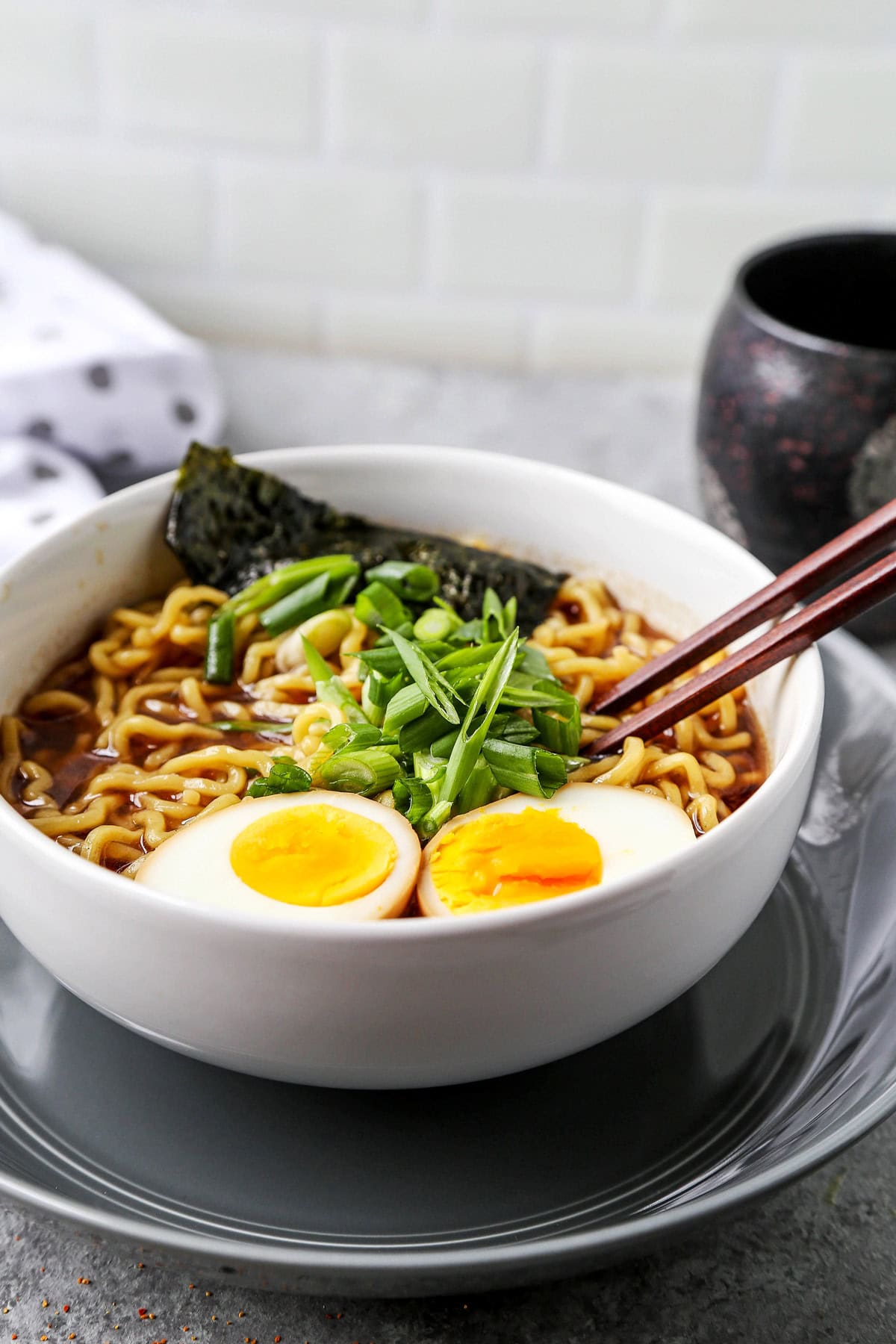
Recipe Variations
- Add chashu. Chashu is sliced Japanese braised pork belly. Very popular.
- Make it vegan. It’s easy to make vegan shoyu ramen by eliminating the traditional fish based dashi stock – and using kelp based kombu dashi instead. Obviously, leave the ramen egg out too.
- Make it spicy. My favorite way to spice up any ramen is by adding rayu (Japanese chili oil). And my husband likes tangy, zingy yuzukosho made with yuzu peels and chili.
EXPAND FOR MORE TOPPING IDEAS
Togarashi, fish cakes, corn, raw minced garlic, stir fried veggies, bean sprouts, mushrooms, kimchi, raw shredded cabbage, etc.
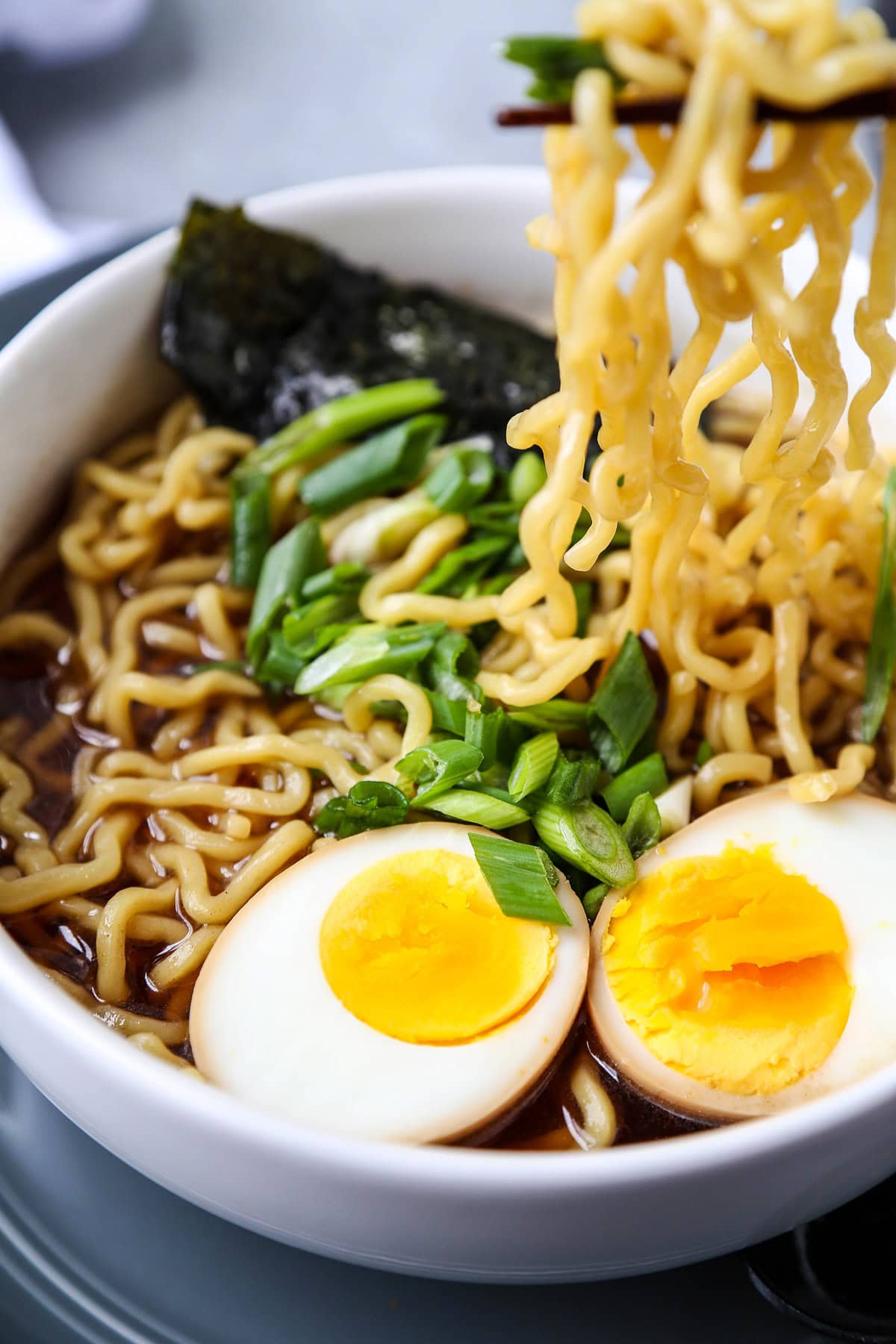
Storage
I do not recommend saving leftover ramen.
But the soup base can be made ahead of time and stored, covered in the refrigerator, for up to 5 days.
There are four primary styles of ramen broth in Japan: miso ramen, shoyu ramen (soy sauce), shio ramen (salt) – and tonkotsu ramen (pork).
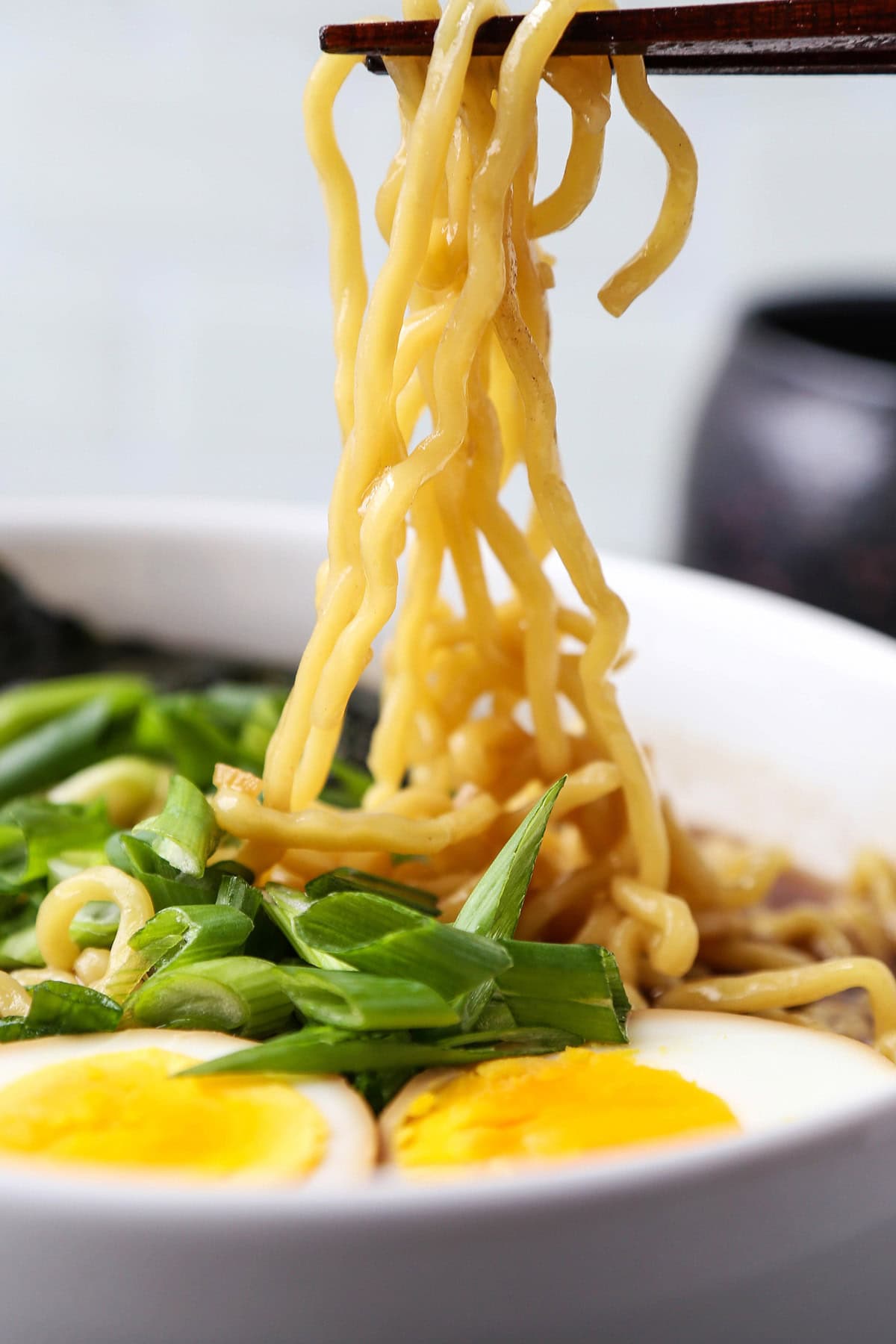
What to Serve With Shoyu Ramen
One of my favorite things about going to a Japanese ramen-ya (ramen shop) is choosing a teishoku (meal set). Think of teishoku as a value-meal that comes with a main dish, a couple of sides and a drink. While a huge steaming bowl of ramen is obviously the main dish, here are a few of my favorite sides for ramen in Japan.
- Yakimeshi – Japanese Fried Rice
- Gyoza with Japanese Dumpling Sauce
- Shiraae – Mashed Tofu Salad
- Seaweed Salad (Kaisou Salada)
- Edamame With Soy and Sesame Sauce
Frequently Asked Questions
They’re probably overcooked. Fresh ramen noodles cook quickly – so I always follow the package cooking instructions and pull them just before they’re al dente.
Just cut it with more hot water. Add more of the pasta cooking water until your broth is just right. Add a little at a time and taste as you go.
Shōyu (醤油) is Japanese for soy sauce.
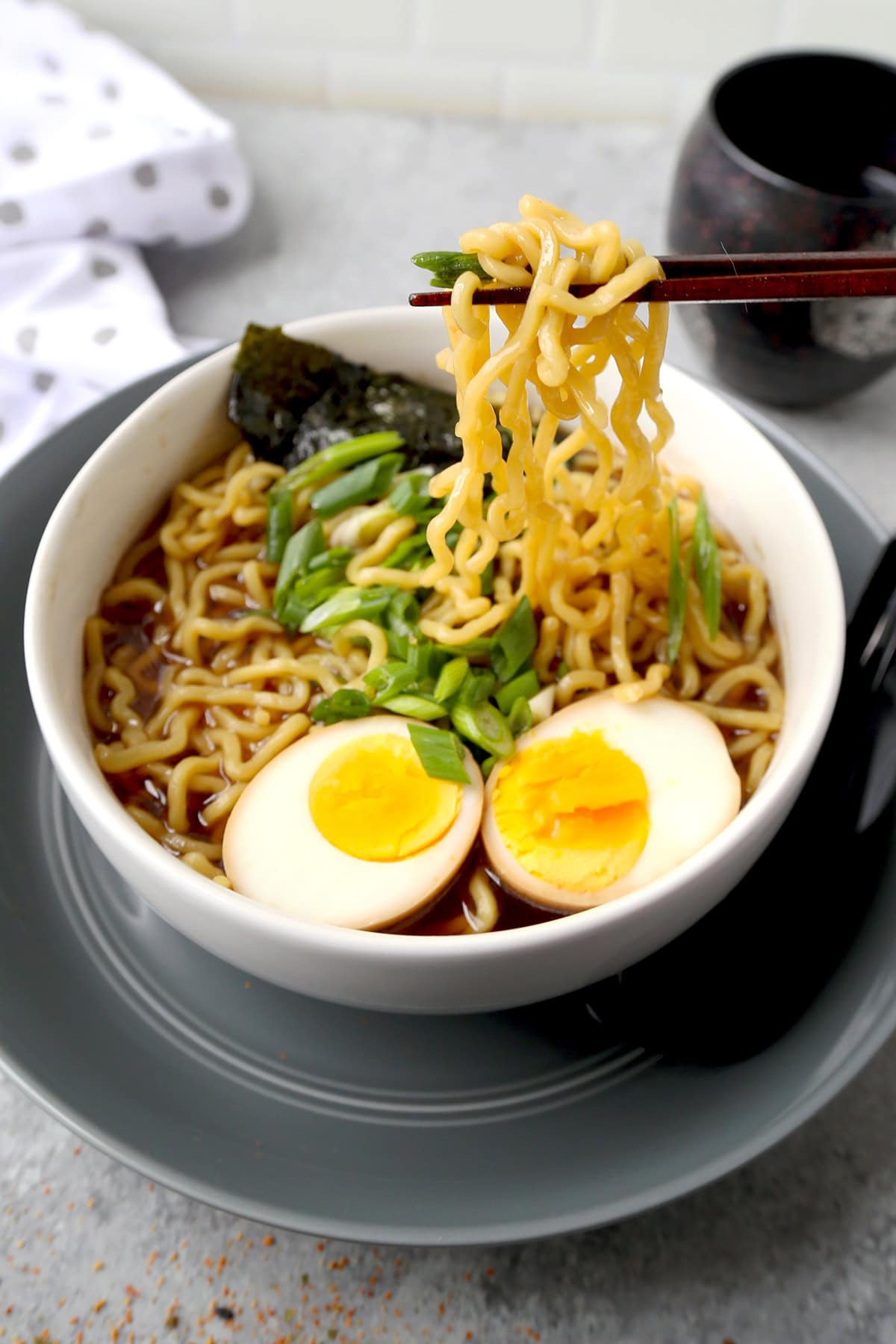
Other simple and delicious Japanese recipes:
Japanese curry, omurice, nasu dengaku, baked chicken katsu, spicy tuna roll, okonomiyaki, onigiri, kani salad.
Did you like this ramen recipe? Are there changes you made that you would like to share? Share your tips and recommendations in the comments section below!
Print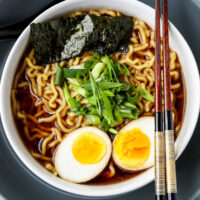
Shoyu Ramen – 醤油ラメーン
- Prep Time: 5 minutes
- Cook Time: 20 minutes
- Total Time: 25 minutes
- Yield: 2 people
- Category: Soup
- Method: Boiling
- Cuisine: Japanese
- Diet: Vegetarian
Description
25 minutes is all it takes to make my restaurant quality Japanese shoyu ramen at home.
Ingredients
- 2 packages fresh ramen noodles
For the shoyu broth:
- 1 tablespoon sesame oil
- 1 clove garlic, minced
- 1 1-inch piece ginger, peeled and minced
- 3 tablespoons soy sauce
- 1 tablespoon cooking sake
- 1 cup dashi
- 2 1/2 tablespoons mirin
- 1 cup ramen water (the pasta water the ramen noodles were cooked in)
Toppings:
- 2 ramen eggs (optional)
- menma – pickled bamboo
- dry nori sheets
- chopped green onions
- ground white pepper
Instructions
- Make the soup base. In a small pot over medium high heat, add sesame oil, garlic and ginger. Sauté for 2 minutes, or until fragrant. Add the remaining ingredients for the soup – EXCEPT the ramen water – and bring to a boil. Lower the heat, cover and simmer on low for 15 minutes. Set aside.
- Cook the noodles. Bring a medium pot of water to boil. Add ramen noodles to the boiling water and cook according to directions on the package. For fresh noodles, it shouldn’t be more than 2-3 minutes.
- Reserve pasta water. Before draining the noodles, scoop 1 cup of boiling ramen water from the noodle pot and add it to the shoyu soup base. Stir.
- Drain the noodles. Drain and divide them into two bowls.
- Assemble and serve. Pour soup into bowls and add desired toppings. Serve immediately.
Notes
You can make the broth ahead of time and store it in the fridge for up to 5 days.
Nutrition
- Serving Size: 1 bowl
- Calories: 397
- Sugar: 9.1g
- Sodium: 2532.4mg
- Fat: 11.2g
- Saturated Fat: 1.9g
- Unsaturated Fat: 4.2g
- Trans Fat: 0g
- Carbohydrates: 54.8g
- Fiber: 2.3g
- Protein: 12.9g
- Cholesterol: 49.3mg
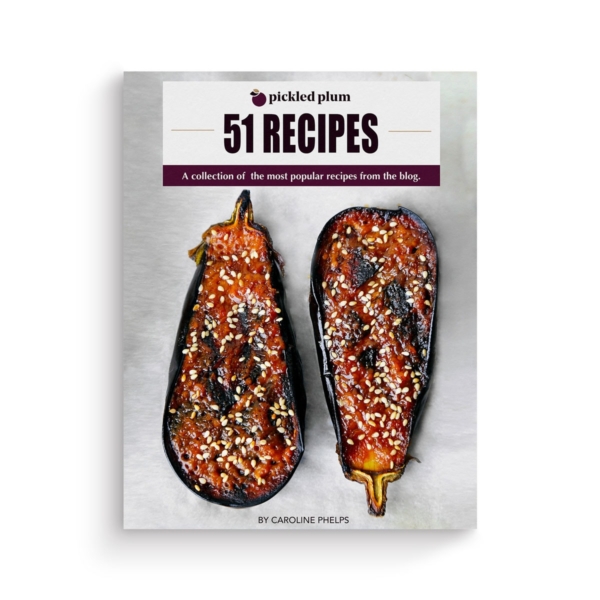
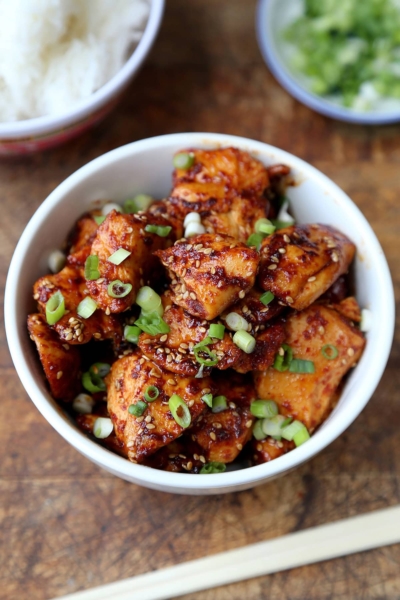
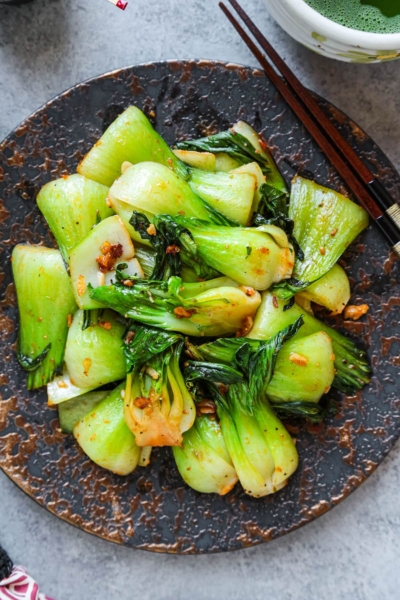

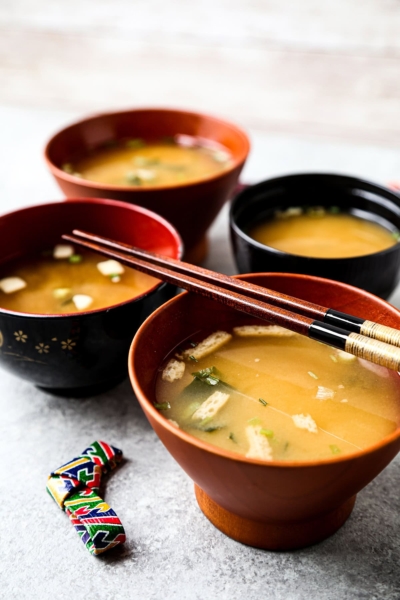

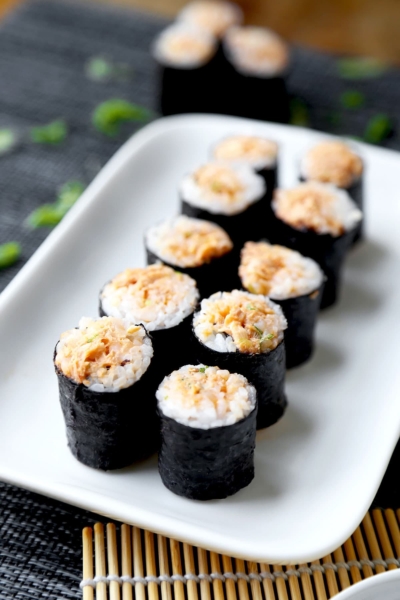








Amazing! Used reduced sodium soy sauce and it’s still amazing. Both my little ones love it too. A go to for sure!
Thank you so much, Caroline! 🙂
Loved this recipe. Very tasty, was definitely a winner in our house. I also added extra kombu to the broth.
Such a fun thing to make but it is incredibly salty. I had to stop eating it because it was so salty. I used the proper amount of I ingradients and even added more water to dilute it. Maybe I used the wrong version of some of the ingredients…?
What is Ramen Water? Is that suppose to be Basic Ramen Broth?
Hi there! The ramen water is the water that you cook the ramen in. I should probably word this differently, I can see how that can be confusing 🙂
Fantastic recipe and we can’t wait to make it but I have one question. The recipe says to use 2 packages of fresh ramen noodles. Would that be 12 ounce packages or something else ?
On a side note I just might also try some of my Grandma and Grandpa’s homemade La Mian just for a little fun fusion experiment 🙂
Hi Brandon, one serving should be around 6 ounces of fresh noodles, la mian noodles is a great substitute! I use this shoyu broth for soba and somen too 😉